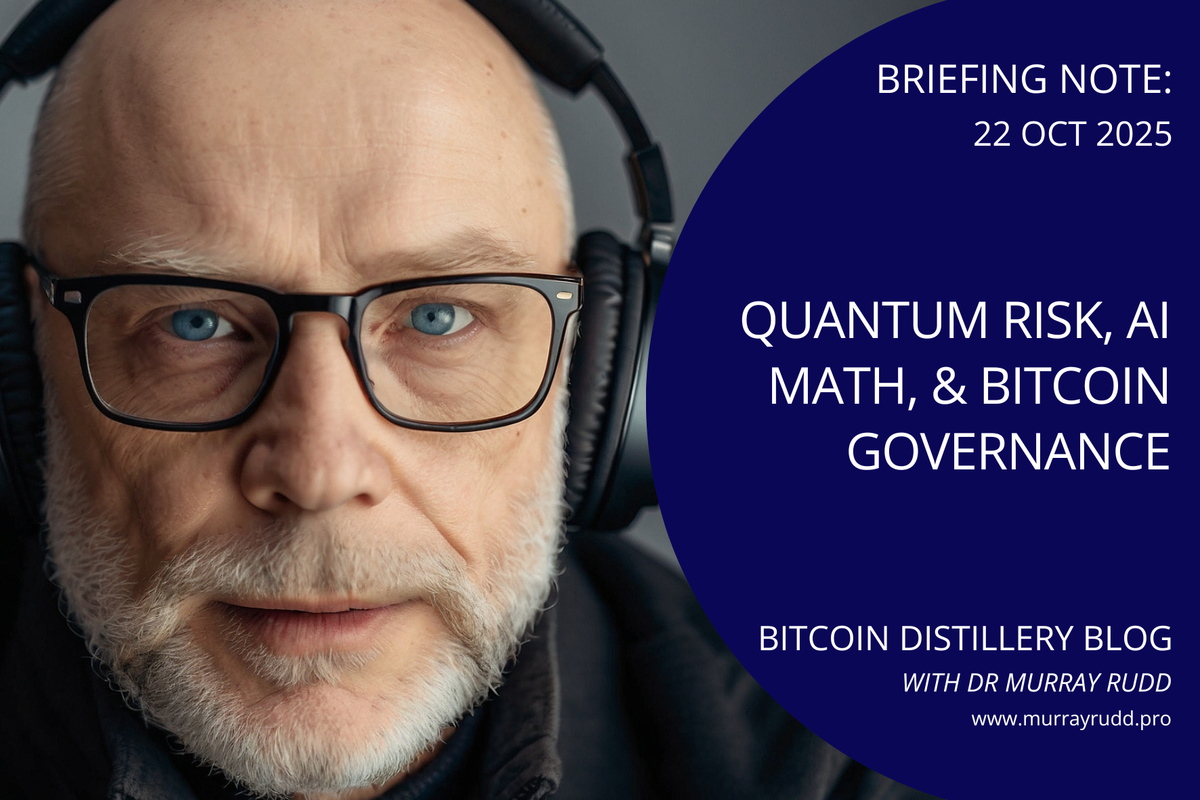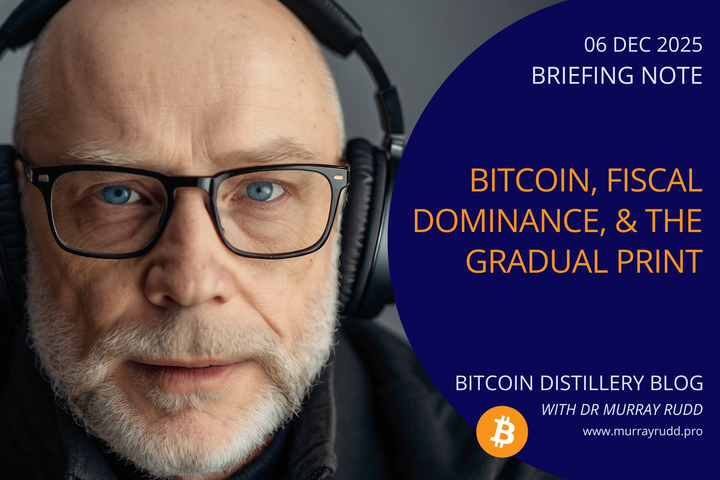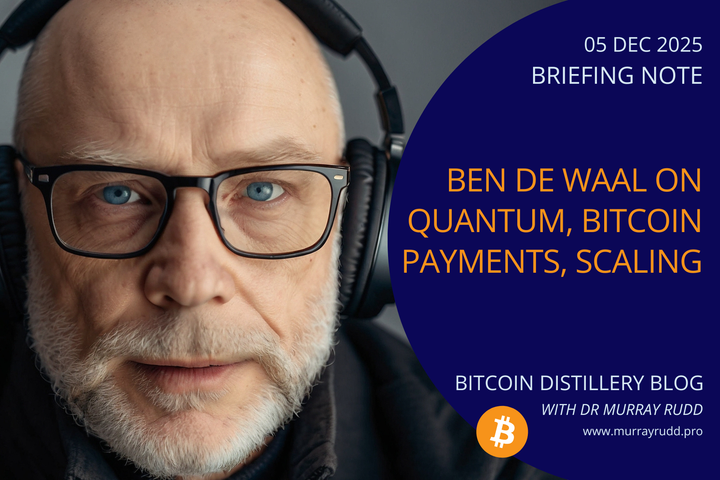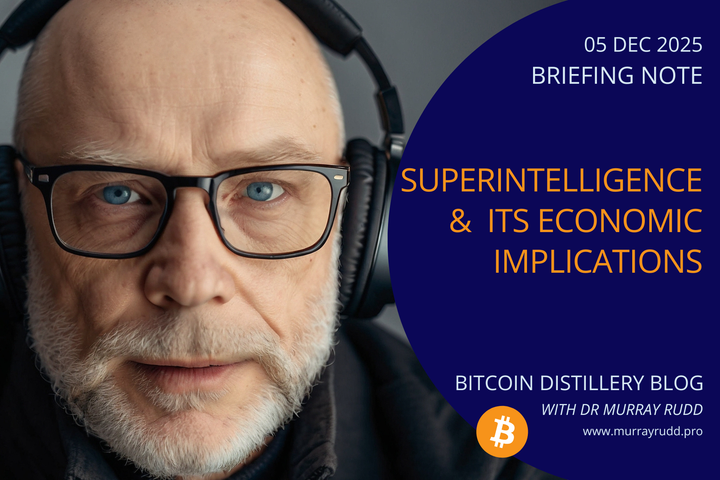Quantum Risk, AI Math, and Bitcoin Governance
The October 15, 2025 episode of the Isabel Foxen Duke podcast features Martin Shkreli assessing whether quantum computing or AI-assisted mathematics could threaten ECDSA-secured Bitcoin.

Briefing Notes contain: (1) a summary of podcast content; (2) potential information gaps; and (3) some speculative views on wider implications for Bitcoin. Most summaries are for Bitcoin-centered YouTube episodes but I also do some on AI and technological advance that spill over to affect Bitcoin.
Summary
The October 15, 2025 episode of the Isabel Foxen Duke podcast features Martin Shkreli assessing whether quantum computing or AI-assisted mathematics could threaten ECDSA-secured Bitcoin. Shkreli argues that logical qubits, gate fidelity, and error-correction overhead keep Shor’s algorithm out of near-term reach, while implementation flaws and nonce leakage remain present risks. He then examines governance, migration triggers, and market responses to any credible break, including treatment of tainted coins and debates over dormant UTXOs.
Take-Home Messages
- Near-term risk: Classical failures—nonce leaks, side channels, and bugs—are more immediate than quantum attacks.
- True quantum bar: Logical qubits, gate fidelity, and error-correction overhead set feasibility for Shor against secp256k1.
- Migration triggers: Define objective milestones and opt-in mechanisms for any post-quantum upgrade path.
- Market plumbing: Exchanges and custodians need playbooks for detecting, quarantining, and pricing tainted coins.
- Norms and law: Policies on dormant UTXOs and “recovery services” must protect property rights and censorship resistance.
Overview
The conversation distinguishes broad quantum hype from the specific conditions required to attack ECDSA, focusing on practical thresholds rather than headlines. Shkreli stresses that physical qubit counts are a misleading proxy because the binding constraints are logical qubits achieved through heavy error correction. On this basis, he argues that credible timelines to break live keys remain distant given today’s noise and fidelity limits.
Attention then shifts to risks that exist today regardless of quantum timelines. Shkreli points to nonce leakage, side-channel exposure, and implementation bugs that can compromise keys without touching elliptic-curve hardness. He frames these as operational failures that standards and audits can meaningfully reduce.
AI appears as a possible accelerator for mathematics rather than a magic key to the vault. Shkreli treats improvements to discrete-log methods and Pollard rho as bounded yet worth monitoring if compute and tooling compound. Even incremental gains could narrow margins for keys with revealed public keys or poor wallet hygiene.
Governance and market coordination complete the assessment. Shkreli contends that any post-quantum migration must be opt-in and size-efficient to avoid chain bloat and political fracture. He evaluates exchange policies on tainted coins, white-hat recovery concepts, and proposals touching dormant UTXOs as stress tests for property rights and censorship resistance.
Stakeholder Perspectives
- Bitcoin core developers: Seek testable triggers and minimal-bloat designs for any post-quantum path while preserving consensus cohesion.
- Wallet and hardware vendors: Prioritize nonce-safe signing, side-channel defenses, and standardized audits to curb present-day failures.
- Exchanges and custodians: Need clear detection, quarantine, and pricing rules for quantum-tainted coins aligned with legal obligations.
- Miners and mining pools: Require guidance to avoid unintended censorship if taint heuristics influence transaction selection.
- Regulators and law enforcement: Weigh export controls, liability regimes, and evidentiary standards if quantum or AI-enabled attacks emerge.
Implications and Future Outlook
If quantum progress crosses credible thresholds, the first-order effect will be governance pressure rather than instant collapse. Clear public milestones and pre-agreed triggers reduce panic and enable orderly, opt-in migration to alternative signatures. In the meantime, the highest leverage lies in eliminating nonce leakage and tightening implementation standards.
Market impact from any credible theft would depend on exchange and custodian coordination. Shared policies on identifying and handling tainted coins would shape liquidity, pricing, and user confidence. Without alignment, fragmentation risk rises and incentives for opportunistic behavior increase.
Debates over dormant UTXOs and recovery services will test property norms. Narrowly scoped, transparent rules reduce precedent creep and protect censorship resistance. Stakeholders that invest early in scenario playbooks will manage shocks with less damage to users and markets.
Some Key Information Gaps
- What qubit counts, error-correction overheads, and gate fidelities are minimally sufficient to run Shor against secp256k1? Establishing concrete thresholds anchors feasibility, urgency, and resource allocation.
- Which post-quantum signature schemes satisfy Bitcoin’s on-chain constraints while preserving verification speed and acceptable transaction sizes? Practical candidates must balance security with efficiency to maintain network usability.
- What governance process and objective triggers can coordinate an opt-in PQC migration without fragmenting the network? Defined milestones and roles lower political contention and support orderly upgrades.
- How would exchanges and custodians identify, quarantine, and price quantum-tainted coins under different attack scenarios? Playbooks for detection and market handling are essential to limit contagion and protect users.
- Can AI-assisted mathematics produce practically relevant improvements in discrete-log attacks within a decade, and what monitoring signals would reveal that? Early-warning indicators guide defensive priorities before risks materialize.
Broader Implications for Bitcoin
Security Economics in a Post-Quantum Era
Even if quantum timelines are long, credible thresholds will change security budgeting and insurance. Firms will price key exposure by signature type, disclosure status, and operational hygiene. This pushes the ecosystem toward measurable security baselines and actuarial products tied to on-chain cryptography.
Standard-Setting as Systemic Risk Management
Open, milestone-driven standards processes can convert tail risks into managed transitions. By defining triggers and interoperability targets, the community reduces coordination failure and fork risk. This approach generalizes to future upgrades beyond signatures.
Market Integrity Under Adversarial Stress
Liquidity, listing policies, and settlement rules will determine whether theft becomes contagion. Harmonized taint handling and disclosure norms can stabilize prices and restore confidence quickly. Disarray invites regulatory intervention and worsens losses for retail users.
Property Norms and Protocol Legitimacy
Rules touching dormant UTXOs or recovery services set precedents for censorship resistance. Poorly scoped interventions erode legitimacy and invite future overreach. Carefully limited policies can address edge cases while preserving the protocol’s social contract.
Monitoring Science to Govern Technology
Technical surveillance of quantum and algorithmic progress will become part of routine risk oversight. Cross-institution dashboards tracking fidelity, error-correction, and peer-reviewed math guide staged responses. This embeds scientific awareness into operational governance for the long term.



Comments ()